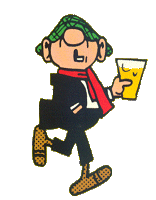
When the 1960s came, many comics had settled in and found a reliable reader base, because of this the comic stalwarts sold steadily throughout the decade. Now comics were seen as a staple for British children, and each child bought their favourite comic weekly. Comics were now coming into their own because of their new contemporary approaches, the artists began to find their own style, and the artwork became as popular as the storyline. The two main publishers brought out many new comic during this decade. IPC created their first real competitor to The Beano and Dandy in 1960. and named it Buster. Buster was an amalgamation of all they had learned from their previous comic ventures. Its title character, Buster, was originally billed as the son of Andy Capp, the star of his own strip in the Mirror. Andy Capp never alluded to Buster in his strip, while only a few cameos appeared of Andy Capp in Buster’s strip. Later on, to avoid any link with the unsavoury nature of some of the Andy Capp strips, Buster’s links to his father were cut and thus became a standalone character in his own comic. Buster comic, being a standout publication for IPC amongst its other less unsuccessful comics, became a “graveyard” for almost all the IPC comics that folded. Just in the ‘60s alone Buster merged with four other IPC comics including Radio Fun and Film Fun in 1961 and 1962 respectively. Often during a merger, the best characters from the deceased comic would join the bigger, more popular comics. Unless these characters were very special they would eventually stop appearing in the comic and all trace of the merged comic would disappear. Whenever a comic was to closed or merge, the ironic tag line read “Great News Inside,” which to most of the readers would signal the end of their favourite comic; this phrase has now become an “in joke” between collectors. Buster was the first comic launched by the newly merged IPC, and paved the way for many more IPC comics to come.
One of these comics was Whizzer and Chips. IPC brought out this title to add to their stable, and give Buster a sister comic. Whizzer and Chips launched in 1969, nine years after Buster, produced many memorable characters. IPC actually billed Whizzer and Chips as two comics in one; Whizzer, whose leader was Sid and his snake, and Chips, whose leader was Shiner. The two comics in one originally billed as companion comics, soon became rivals. Later on, the rivalry played out in the comics as well as between groups of children. Back in the 1970s, being either a Whizzer or a Chipite could cause cliques and gangs among the children. The comic would also play on this rivalry by having what they called “raiders.” These raiders would be a character from the opposite comic that hid in amongst the other comic’s strips. This provided children with an extra bit of fun once they had finished reading the comic. If you were wondering, I would call myself a Whizzer.
After the launch of Buster, and before Whizzer and Chips came out, D.C. Thomson put out their fare for the ‘60s. Sparky, launched in 1967, became their fifth humour comic. It contained the same zany and fun filled pages as its predecessors did. Sparky took many of the defunct characters from the early Beano and Dandy comics and refreshed them for the modern audience. Keyhole Kate, Hungry Horace, and Freddie the Fearless Fly from The Dandy and Pansy Potter, Hairy Dan, and Frosty McNab from The Beano had makeovers when they reappeared in the Sparky. Apart from these standout humour comics, IPC and D.C. Thomson also brought out many boys’ papers during this period. D.C. Thomson launched the Victor and Hornet in 1961 and 1963 respectively, while IPC brought out Valiant in 1962 and the five Power Comics, Wow!, Smash!, Pow!, Fantastic, and Terrific between 1967 and 1968. Sadly, with the success of the new humour comics coming onto the market, D.C. Thomson’s “Big Five” disappeared in this decade. The industry became humour only with a pinch of adventure offered by the boys’ papers. Text stories also lost popularity during this period. If children wanted a comic, they did not want to read stories as if they were from a book; they wanted action, jokes, and japery from the comic strips. The 60s were known as an era of psychedelic colour and the comics were no exception; the new comics brought out reflected the mood by adding more colour on the front cover as well as the content inside.


